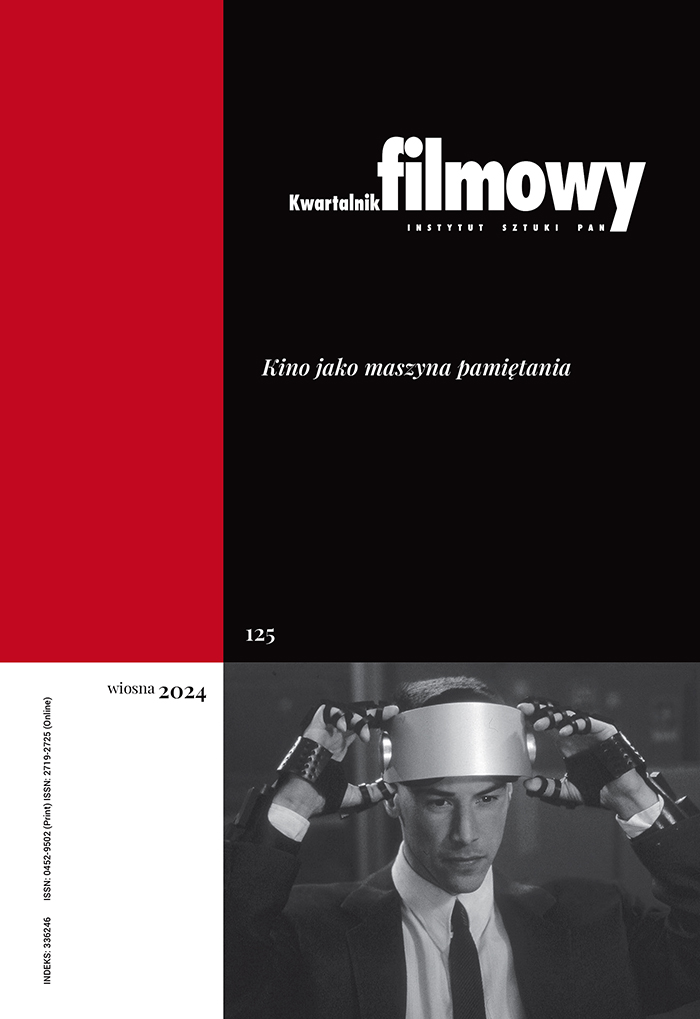The Beginnings of Documentary Film in Japan
Abstract
The article deals with the beginnings of Japanese film documentaries, their development and use as tools of the government propaganda in the 1930s. Two turning points demand particular attention - the first is related to the theoretical debate waged between advocates of politically engaged cinema and the supporters of the modernist avant-garde, which resulted in the emergence of a new proletarian cinema movement (Purikino) and numerous newspaper articles and books. The second turning point was the involvement of artists in the nationalist project imposed by the Tokyo government once Japan engaged in the hostilities in Southeast Asia. A particular manifestation of the new activity was the successful transfer of the German concept of culture film (Kulturfilm) to Japan, which here was called bunka eiga. The most prominent filmmaker who joined the movement, but who retained a critical stance to the dominant ideology was Fumio Kamei, the author of the “Chinese trilogy”, and the Fighting soldiers, which films are nowadays considered to be the most important achievements of the Japanese film industry at the time. The analysis of his films allow one to fully understand the ideological and aesthetic consideration of the period.
Keywords:
documentary film, Japan, Fumio KameiReferences
Baskett Michael, The Attractive Empire: Transnational Film Culture in Imperial Japan, Honolulu: University of Hawai’i Press 2008, s. 8.
DOI: https://doi.org/10.21313/hawaii/9780824831639.001.0001
Google Scholar
Davis William D., Picturing Japaneseness: Monumental Style, National Identity, Japanese Film, New York: Columbia University Press 1996, s. 67.
Google Scholar
High Pater B., The Imperial Screen: Japanese Film Culture in the Fifteen Years’ War, 1931-1945, Madison: University of Wisconsin Press 1995.
Google Scholar
Hiroshi Komatu, Kigen no eiga, Tōkyō: Seidōsha 1991, s. 287–314.
Google Scholar
Loska Krzysztof, Benshi jako współautor filmu, „Kwartalnik Filmowy” 2007, nr 59, s. 59-66.
Google Scholar
Nornes Abè Mark, Forest of Pressure: Ogawa Shinsuke and Postwar Japanese Documentary, Minneapolis: University of Minnesota Press 2007.
Google Scholar
Nornes Abé Mark, Fukushimy Yukio, The Japan/America Film Wars: World War II Propaganda and Its Cultural Contexts, Harwood Academic Publishers 1994.
Google Scholar
Nornes Abè Mark, Japanese Documentary Film: The Meiji Era Through Hiroshima, Minneapolis: University of Minnesota Press 2003.
Google Scholar
Puroretaria eiga no chishiki, red. Iwasaki Akira, T. Murayama Tomoyoshi, Tōkyō: Naigaisha 1932.
Google Scholar
Puroretaria eiga undō no tenbō, red. Matsuzaki Keiji, Tōkyō: Daihōkaku 1930.
Google Scholar
Authors
Krzysztof Loskakwartalnik.filmowy@ispan.pl
Jagiellonian University Poland
Profesor UJ; zajmuje się kulturą popularną, postmodernizmem, literaturą współczesną i kinem gatunkowym. Autor m.in. Dziedzictwa McLuhana. Między nowoczesnością a ponowoczesnością (2001), Encyklopedii filmu science fiction (2004), Tożsamości i mediów (2006). Współautor (z Andrzejem Pitrusem) książek: 100 filmów science fiction (2000) i David Cronenberg: rozpad ciała, rozpad gatunku (2003).
Statistics
Abstract views: 28PDF downloads: 9
License
Copyright (c) 2011 Krzysztof Loska

This work is licensed under a Creative Commons Attribution 4.0 International License.
The author grants the publisher a royalty-free non-exclusive licence (CC BY 4.0) to use the article in Kwartalnik Filmowy, retains full copyright, and agrees to identify the work as first having been published in Kwartalnik Filmowy should it be published or used again (download licence agreement). The journal is published under the CC BY 4.0 licence. By submitting an article, the author agrees to make it available under this licence.
In issues from 105-106 (2019) to 119 (2022) all articles were published under the CC BY-NC-ND 4.0 licence. During this period the authors granted a royalty-free non-exclusive licence (CC BY-ND 4.0) to use their article in „Kwartalnik Filmowy”, retained full copyright, and agreed to identify the work as first having been published in our journal should it be published or used again.
Most read articles by the same author(s)
- Krzysztof Loska, Memory, Performance and Affects – Genocide in the Films by Joshua Oppenheimer , Kwartalnik Filmowy: No. 111 (2020): Senses and Affects
- Krzysztof Loska, „Tropical Malady”, or on Humans, Animals and Spirits in Apichatpong Weerasethakul’s film , Kwartalnik Filmowy: No. 110 (2020): Beyond Human Being
- Krzysztof Loska, Journey to the New World. Cinematic Ethnographic Fiction in Post-Colonial Perspective , Kwartalnik Filmowy: No. 107 (2019): Journey, (E)migration, Pilgrimage
- Krzysztof Loska, Apichatpong Weerasethakul – About Politics and Spectres , Kwartalnik Filmowy: No. 105-106 (2019): Cinema and Political Transformation
- Krzysztof Loska, Architecture and Japanese Colonialism – Cinematic Image of Cityscape in Occupied Seoul , Kwartalnik Filmowy: No. 109 (2020): Architectural Space in Film
- Krzysztof Loska, Histories of Polish Migrants in European Cinema , Kwartalnik Filmowy: No. 109 (2020): Architectural Space in Film
- Krzysztof Loska, From the Point of View of Indigenous Peoples: Film as a Tool of Decolonization in Canada , Kwartalnik Filmowy: No. 116 (2021): Cinema and Social Identity
- Krzysztof Loska, Life in the Shadow of a Nuclear Power Plant (Fukushima – Ten Years Later) , Kwartalnik Filmowy: No. 114 (2021): Contamination, Dirt, Flaw
- Krzysztof Loska, Oscar Micheaux and the Beginnings of African-American Cinema , Kwartalnik Filmowy: No. 117 (2022): Unknown/Hidden Cinema
- Krzysztof Loska, Lav Diaz, Revolution and Messianic Time , Kwartalnik Filmowy: No. 123 (2023): Pace and Rhythm











